Related Research Articles

The Honourable Society of the Middle Temple, commonly known simply as Middle Temple, is one of the four Inns of Court exclusively entitled to call their members to the English Bar as barristers, the others being the Inner Temple, Gray's Inn and Lincoln's Inn. It is located in the wider Temple area of London, near the Royal Courts of Justice, and within the City of London.

The Honourable Society of Lincoln's Inn is one of the four Inns of Court in London to which barristers of England and Wales belong and where they are called to the Bar. Lincoln's Inn, along with the three other Inns of Court, is recognised as being one of the world's most prestigious professional bodies of judges and lawyers.
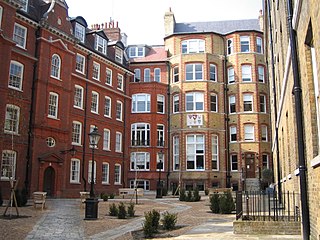
The Honourable Society of the Inner Temple, commonly known as the Inner Temple, is one of the four Inns of Court and is a professional associations for barristers and judges. To be called to the Bar and practise as a barrister in England and Wales, a person must belong to one of these Inns. It is located in the wider Temple area, near the Royal Courts of Justice, and within the City of London.
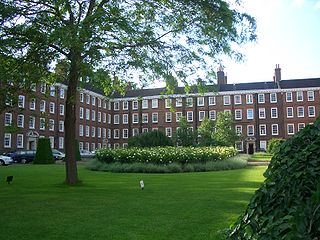
The Honourable Society of Gray's Inn, commonly known as Gray's Inn, is one of the four Inns of Court in London. To be called to the bar in order to practise as a barrister in England and Wales, an individual must belong to one of these inns. Located at the intersection of High Holborn and Gray's Inn Road in Central London, the Inn is a professional body and provides office and some residential accommodation for barristers. It is ruled by a governing council called "Pension," made up of the Masters of the Bench and led by the Treasurer, who is elected to serve a one-year term. The Inn is known for its gardens which have existed since at least 1597.

The Inns of Court in London are the professional associations for barristers in England and Wales. There are four Inns of Court – Gray's Inn, Lincoln's Inn, Inner Temple and Middle Temple.

The Temple is an area of London surrounding Temple Church. It is one of the main legal districts in London and a notable centre for English law, historically and in the present day. It consists of the Inner Temple and the Middle Temple, which are two of the four Inns of Court and act as local authorities in place of the City of London Corporation as to almost all structures and functions.

The Inns of Chancery or Hospida Cancellarie were a group of buildings and legal institutions in London initially attached to the Inns of Court and used as offices for the clerks of chancery, from which they drew their name. Existing from at least 1344, the Inns gradually changed their purpose, and became both the offices and accommodation for solicitors and a place of initial training for barristers.

Barristers in England and Wales are one of the two main categories of lawyer in England and Wales, the other being solicitors. Barristers have traditionally had the role of handling cases for representation in court, both defence and prosecution.
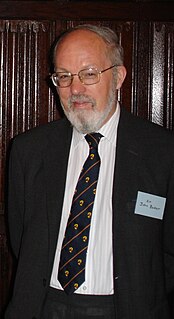
Sir John Hamilton Baker, QC, LLD, FBA, FRHistS is an English legal historian. He was Downing Professor of the Laws of England at the University of Cambridge from 1998 to 2011.
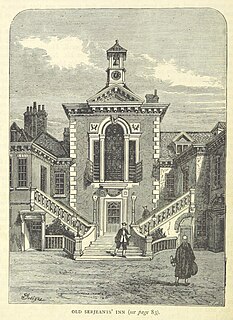
Serjeant's Inn was the legal inn of the Serjeants-at-Law in London. Originally there were two separate societies of Serjeants-at-law: the Fleet Street inn dated from 1443 and the Chancery Lane inn dated from 1416. In 1730, the Fleet Street lease was not renewed and the two societies merged. The society's relevance diminished as Serjeants-at-Law were gradually superseded by Queen's Counsel in the nineteenth century. The building in Chancery Lane was sold in 1877 and the assets were distributed amongst the surviving members, although the society was not formally dissolved. The last member, Lord Lindley, died in 1921. The Fleet Street building was destroyed in the 1941 bombing raids during World War II.

The City Law School is one of the five schools of City, University of London. In 2001, the Inns of Court School of Law became part of City, and is now known as The City Law School. Until 1997, the ICSL had a monopoly on the provision of the Bar Vocational Course (BVC), now known as Bar Vocational Studies (BVS), formerly the Bar Professional Training Course (BPTC), the obligatory professional training for would-be barristers in England and Wales, before they commence pupillage.
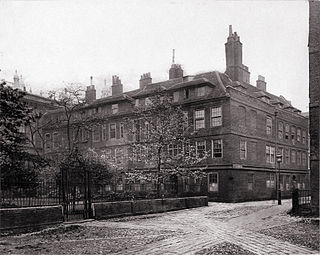
Clifford's Inn is a former Inn of Chancery in London. It was located between Fetter Lane, Clifford's Inn Passage, leading off Fleet Street and Chancery Lane in the City of London. The Inn was founded in 1344 and refounded 15 June 1668. It was dissolved in 1903, and most of its original structure was demolished in 1934. It was both the first Inn of Chancery to be founded and the last to be demolished.
Lyon's Inn was one of the Inns of Chancery attached to London's Inner Temple. Founded some time during or before the reign of Henry V, the Inn educated lawyers including Edward Coke and John Selden, although it was never one of the larger Inns. It eventually developed into an institution of disrepute rather than of respect, and by the time it was dissolved in 1863 it was inhabited by only the worst lawyers.
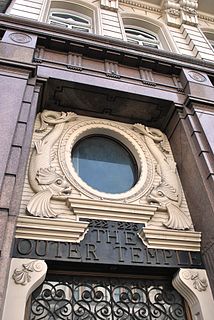
The Outer Temple is a building next to the Temple in London, just outside the City of London. In the 14th century, the property seized from the Knights Templar was divided, and that part of the Temple property then just outside London was given the name Outer Temple. It has been suggested that the name Outer Temple once also referred to an Inn of Chancery; its historical existence was first posited by A. W. B. Simpson and confirmed by John Baker in 2008. Little is known of it, other than that it lacked a hall; Baker suggests that this is the reason that it did not survive long enough to appear in many records. Other writers have insisted that it was never an inn: Sir George Buck wrote in 1612 "the Utter Temple neither is nor was ever any college or society of students".
A reader in one of the Inns of Court in London was originally a senior barrister of the Inn who was elected to deliver a lecture or series of lectures on a particular legal topic. Two readers would be elected annually to serve a one-year term.

Stone Buildings, Lincoln's Inn were constructed from 1774 to 1780. The architect was Sir Robert Taylor. Stone Buildings is a Grade I listed building. Stone Buildings appear in Anthony Trollope's novel The Prime Minister.
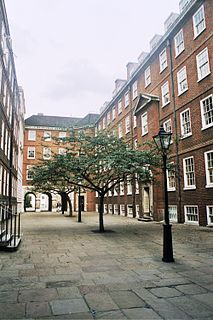
Pump Court, Temple, London was the first on the left in Middle Temple Lane from 6 Fleet Street, leading to Inner Temple Lane and Lamb's Buildings. Its name referred to the pump in the middle.

King's Bench Walk is a street in Temple, in the City of London. It is mainly made up of barristers' chambers.

Edward George "Ted" Nugee was an English barrister. Nugee was described in his London Times obituary as "one of the pre-eminent Chancery barristers of his generation". He was involved in number of significant cases on tax and pensions, as well as being a regularly published correspondent in letters to the editor of The Times.
The New Inn was one of the Inns of Chancery or Hospida Cancellarie. It existed from the late 15th century until 1902 and was located near Aldwych in London.
References
- ↑ Report of the Commissioners Appointed to Inquire Into the Arrangements in the Inns of Court and Inns of Chancery, for Promoting the Study of the Law and Jurisprudence; Together with Appendices: Presented to Both Houses of Parliament by Command of Her Majesty, printed by G.E. Eyre and W. Spottiswoode, for H.M. Stationery Office, 1855
- 1 2 "The Role of the Inns of Court in the Provision of Education and Training for the Bar" (PDF). Middle Temple. p. 36. Retrieved 9 April 2019.
- 1 2 3 Davis, John P. (2000). Corporations: A Study of the Origin and Development of Great Business Combinations and of Their Relation to the Authority of the State. Beard Books. p. 47. ISBN 9781587980114 . Retrieved 2 April 2019.
- 1 2 3 4 5 "Inns Of Court Bill 10 July 1874". Hansard. House of Lords. Retrieved 2 April 2019.
- 1 2 3 4 5 Coletti, Emma (1 December 2017). "Inns of Chancery". Gray's Inn. Retrieved 9 April 2019.
- 1 2 Kruisinga, E. (1 January 1919). "The Inns of Court". English Studies. 1 (1–6): 4. doi:10.1080/00138381908596367. ISSN 0013-838X.
- 1 2 3 4 "Staple Inn Reading 1998". Institute and Faculty of Actuaries.
- ↑ "List of commissions and officials: 1850-1859 (nos. 53-94)". British History Online. Institute of Historical Research, University of London. Retrieved 2 April 2019.
- 1 2 "Resolutions: HC Deb 01 March 1872 vol 209 cc1221-95". Hansard. House of Commons. Retrieved 2 April 2019.
- ↑ Cocks, Raymond (2004). Sir Henry Maine: A Study in Victorian Jurisprudence. Cambridge University Press. p. 49. ISBN 9780521524964 . Retrieved 2 April 2019.
- 1 2 Cawthorne, Nigel (2016). The Ludicrous Laws of Old London. Little, Brown Book Group. p. 104. ISBN 9781472136657 . Retrieved 9 April 2019.
- ↑ Cawthorne, Nigel (2016). The Ludicrous Laws of Old London. Little, Brown Book Group. p. 105. ISBN 9781472136657 . Retrieved 9 April 2019.
- ↑ Cawthorne, Nigel (2016). The Ludicrous Laws of Old London. Little, Brown Book Group. pp. 106–107. ISBN 9781472136657 . Retrieved 9 April 2019.
- 1 2 Cawthorne, Nigel (2016). The Ludicrous Laws of Old London. Little, Brown Book Group. pp. 107–108. ISBN 9781472136657 . Retrieved 9 April 2019.
- ↑ Cawthorne, Nigel (2016). The Ludicrous Laws of Old London. Little, Brown Book Group. pp. 108–109. ISBN 9781472136657 . Retrieved 9 April 2019.
- 1 2 3 Cawthorne, Nigel (2016). The Ludicrous Laws of Old London. Little, Brown Book Group. pp. 109–110. ISBN 9781472136657 . Retrieved 9 April 2019.
- ↑ "The Inns Of Court & Inns Of Chancery & their Records". Inner Temple. Retrieved 3 April 2019.
- ↑ Zander, Michael (1 January 1966). "Essays in Law Reform". The Political Quarterly. 37 (1): 39. doi:10.1111/j.1467-923X.1966.tb00182.x. ISSN 1467-923X.
- ↑ Brooke, Christopher; Leader, Damian Riehl; Morgan, Victor; Searby, Peter (1988). A History of the University of Cambridge: 1870-1990. Cambridge University Press. p. 217. ISBN 9780521343503 . Retrieved 2 April 2019.
- ↑ Coquillette, Daniel R.; Kimball, Bruce A. (2015). On the Battlefield of Merit: Harvard Law School, the First Century. Harvard University Press. pp. 4–35. ISBN 9780674967663.